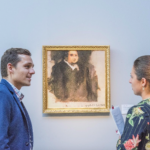
By Obvious
GANS on Photography
We are Obvious, a collective of three friends and researchers, which explores AI as a means to create art.
One of the most important AI tools for visual creation we use are GANs. Their advent for artistic creation has started since their invention by I. Goodfellow in 2014. In their beginnings GANs use to produce low-resolution images. They slowly evolved, thanks to the work of researchers, into powerful algorithms capable of producing high-resolution realistic images. In the early days, they were only accessible to tech educated people as there was no user friendly interface developed yet to use those. Efforts have been made to make GANs more accessible, with platforms such as RunwayML, yet it is still a challenge to bring this new tool to creative people in general.
Some properties are inherent to the technology: GANs are able to replicate images based on a large number of examples, and in that way they raise questions of reproducibility. The way GANs work create a new relationship between the creator and his tool, as the manipulation of latent spaces is a whole new way of approaching visual creation. In that sense, it makes the role of the artist evolve, giving a new perspective to his place in the creative process. In that sense, it makes the role of the artist evolve, giving a new perspective to his place in the creative process.
These observations are born from our experience in working with those algorithmic models. We also had the chance to have a large mediatic attention on our work at the occasion of the auction of Edmond de Belamy in 2018 at Christie’s. This event allowed us to be at the center of debates on the advent of this new type of technology and the impact it can have on artists, the art world, and creation as a whole. Confronting our work to a large audience allowed us to have a substantial validation of how GANs were perceived: as extremely interesting tools in terms of creation, which is also feared for the characteristics listed precedently.
Edmond de Belamy, Obvious, GANs trained on portraits and printed on Canvas, 2018
Resistance to change is present in most of us, and technology will always be feared by most before getting adopted. Especially when the technology is perceived as autonomous in performing one of the most complex tasks usually trusted to us humans. We believe that this resistance is born from lack of information. Indeed, when creating with an algorithm, the artist still has the hand on the final visual even though she or he doesn’t create it with conventional means. Curating the database which will be used for feeding the algorithm, building and tweaking the algorithm, choosing the output between the many outcomes of the different algorithmic trainings, choosing the medium and finding an artistic coherence which will hold a strong artistic statement. All those parts of the artistic process are still reserved to the artist. The main difference happens in the part characterized by pure image creation, where the artist takes a step back and lets the algorithms work autonomously, and learn how to create in their own way.
Sacred Heights, Obvious, GANs trained on Ukiyo-e landscapes, printed using the traditional japanese Moku-Hanga technique.
We couldn’t help but seeing the parallel with another technology which appeared around 1840: Photography. Photography could only be used by highly qualified engineers, produced some blurry outputs, allowed high replicability and was therefore feared by artists who were afraid to see their job disappear. At its beginnings, the technology received its fair share of praises and criticisms. Today, we can observe that this technology has been widely adopted. It has impacted copyist artists only, is used as a means of communication, and allows everyone around the world to be creative in a new way. Besides, it has created a new branch in the art field, with its specificities, its share of great artists, and its renowned masterpieces.
Algorithma Obscura, Obvious, GANs trained on daguerreotypes, 2020
We decided to create a series of artworks which shreds light on this parallel. We trained GANs on daguerreotypes, and extracted a series of images which represent the algorithmic re-interpretation of the first visuals created using this revolutionary tool: photography. By combining the very first steps of photography with those of GANs, we wish to display the future we see for AI and its creative use: we believe it will gain in accessibility, create a new art movement, and eventually be made available to everyone to help boost creativity. This is one of our main motivations in continuing the paving of the way for the use of algorithms as an artistic tool.
The Nouvel Appareil Gaudin Algorithm, Obvious, GANs trained on daguerreotypes, 2020
We are at a turning point in the art world, as it crosses and integrates science once again, changing the horizon of possibles allowing an evolution of the creative process, of the relationship between an artist and his tool, and letting in a new generation of artists with a different set of skills, visions and ideas. Exciting times !
Art

Curated Conversations: ALIENQUEEN
SuperRare Labs Senior Curator An interviews ALIENQUEEN about psychedelics, death, and her journey in the NFT space.
Tech


Out of the Vault and onto the Chain: the Evolving Nature of Provenance
SuperRare editor Oli Scialdone considers the social experience of provenance and its relationship with community in the Web3 space.
Curators' Choice



Curated Conversations: ALIENQUEEN
SuperRare Labs Senior Curator An interviews ALIENQUEEN about psychedelics, death, and her journey in the NFT space.



